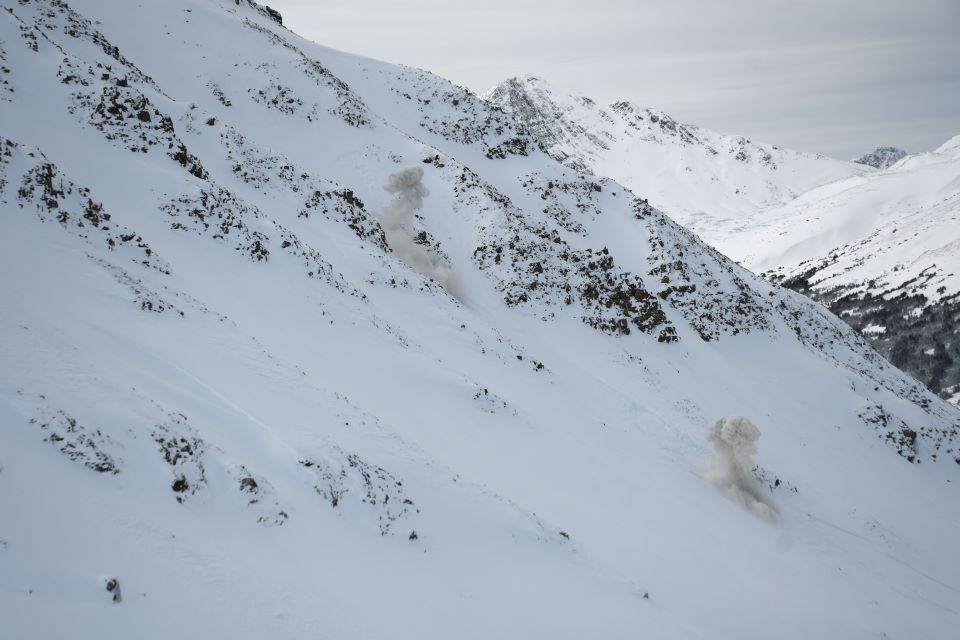Jasper’s ski resort showed guests how its ski patrol manages terrain and ensures the mountain is safe during Avalanche Awareness Day on Saturday (Jan. 18).
Marmot Basin gave guests a chance to learn about avalanche control at its information booth, meet Mac, an avalanche rescue dog, and see an explosives demo at the top of the Paradise Chair.
“We really want to get messaging across about why some of our terrain might be closed and why it’s not safe for people to go underneath our ropes that do say, ‘Closed: Avalanche Danger,’” said Kerry MacDonald, director of public safety for Marmot Basin.
Avalanche Awareness Day is hosted annually at Marmot Basin in conjunction with Jasper in January and Avalanche Canada’s Avalanche Awareness Days, with the explosives demo ending the event with a bang.
Matt Knop, a snow safety expert at Marmot Basin, explained just before the demo how they used a five-kilogram bag of ammonium nitrate and fuel oil that was on a timed fuse for 2.5 minutes.
“They’ll slide the shots down the slope on a rope, and then we can put them right where we need it to trigger whatever the avalanche problem is,” Knop said.
Through a memorandum of understanding with Parks Canada, Marmot Basin is responsible for making avalanche-related decisions as well as whether terrain should be open or closed to the public.
“We focus on anywhere that there’s the potential for avalanches to interact with either guests or staff, or them to interact with the avalanches,” MacDonald said. “There is a certain piece of terrain that might look quite flat and quite benign, but in reality, there is avalanche potential from above to come down and interact with people from those areas.”
More than 300 hectares of Marmot Basin’s 750 hectares of terrain are either avalanche terrain or affected by avalanche terrain. Due to the risk of avalanche, much of this area is closed to the public.
“Explosives is what we use whenever we feel that the resulting avalanches could be big enough to injure or kill a person,” MacDonald said. “For smaller avalanches, we will use ski cutting where we go in and actually try to trigger an avalanche, and our goal of avalanche control, in general, is to make more small avalanches and keep our snow on the slopes where we can actually ski it.”
A major worry for the ski resort is guests entering closed areas. MacDonald noted people may get injured if they do this, and staff would have to go in after them and also be put at risk.
Anyone found in an avalanche closure will have their pass removed and be made aware of why the area was closed.
“If you are at the skill hill, please respect our avalanche closures,” MacDonald said. “They are there for your safety and that of my staff, and we do work really hard to try and get that terrain open for everyone, and it’s quite disrespectful when people don’t respect those closures and they do enter them.”
Mark Bender, a senior avalanche forecaster with Avalanche Canada, said avalanche risk depended on various factors, but the risk tended to be highest following a large snowfall.
“That combined with a little bit of warming and a little bit of wind would create perfect conditions to create avalanche danger,” Bender said.
In the springtime, the snowpack tends to be frozen in the morning before it weakens in the afternoon when it warms up.
Bender encouraged recreationalists to take an avalanche awareness course so they could learn about the dangers in the backcountry, what kind of gear to carry and how to recognize avalanche terrain.
“The more that people are informed, the better off they are,” he said, also encouraging recreationalists to travel with partners who are also carrying avalanche safety gear such as a transceiver, shovel and probe.
Avalanche Canada’s website reports the avalanche risk for Western Canada. Data from the national parks comes from Parks Canada, and Alberta Parks provides forecasts for Kananaskis Country. Avalanche Canada produces forecasts for mountains within British Columbia and the Yukon.
Jasper National Park had a “moderate” danger rating for its alpine and treeline areas as of Thursday (Jan. 23). Recreationalists are asked to be wary of wind slabs and their potential to trigger deeper instabilities. Most alpine and treeline areas have been affected by wind.



